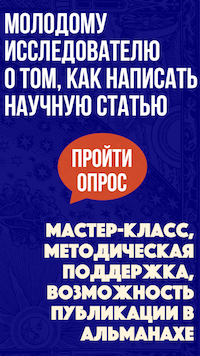МОЛОДЁЖНЫЙ ПРОЕКТ ДЛЯ ТЕХ, КТО ДЕЛАЕТ ПЕРВЫЕ ШАГИ В НАУКЕ
/components/bitrix/system.auth.form/auth_alm/images/login.gif) Войти
Войти /components/bitrix/system.auth.form/auth_alm/images/register.gif) Регистрация
Регистрация
Войти в корпоративную почту как автор/член редколлегии/рецензент журнала




Концепция организованного геополитического пространства: инфраструктурная организация приграничных ТВД в постклассическую эпоху
Тынянова О.Н.
Концепция организованного геополитического пространства: инфраструктурная организация приграничных ТВД в постклассическую эпоху
Тынянова Ольга Николаевна, кандидат политических наук, ведущий инженер Института физики Земли РАН, научный сотрудник бюро военно-научной информации Военного университета Министерства обороны РФ, вице-президент Отделения погранологии Международной академии информатизации. E-mail: ucg.ltd@list.ru, pro_gnosis@mail.ru
Представлен авторский подход к трактовке категории «геополитическое пространство», основанный на теории динамического социального пространства А.Б. Докторовича. Дан краткий анализ соотношения «территориального» и «пространственного» в геополитике, представлены авторская классификация универсальных ресурсов власти и оригинальное определение размерности социального в целом и геополитического в частности пространства. Организация пространства трактуется в духе социологии Бурдьё — Лефевра — Докторовича, культурологии М. Фуко и тектологических идей А.А. Богданова, на основании чего автором были уточнены отдельные дефиниции («геополитическое пространство», «пограничное пространство», «приграничные театры военных действий (ТВД)»), выделены приграничные и пограничные ТВД, а также предложена периодизация эволюции их инфраструктурной организации. Обосновывается вывод о переходе в постклассический период к новому типу геополитической практики — «геополитике знания».
Ключевые слова: концептуализация; геополитическое пространство; пограничное пространство; инфраструктурная организация пространства; приграничный театр военных действий; спатиализация; модальность; власть; знание; «геополитика знания».
Tynyanova O.N. The Concept of Organized Geopolitical Space: Infrastructural Organization of Border Theaters of Operations in the Post-Classical Epoch
Olga N. Tynyanova, PhD (Political Sciences), Chief Engineer at the RAS Institute of the Physic of the Earth, Researcher at Bureau of Military Scientific Information, Military University, Ministry of Defense of the Russian Federation, Vice-President of the Pogranologyi (Border Science) Branch at the International Informatization Academy
E-mail: ucg.ltd@list.ru; pro_gnosis@mail.ru
The article is a detailed exposition of the author's approach to the interpretation of the category "geopolitical space" based on the A. Doctorovich's dynamic social space theory. Thus, by analyzing the using of categories "spatial" and "spatial" in geopolitical research we found that 1) those categories are used by default as identical, 2) geopolitics investigates "places" (loci) and the plane (surface) instead of the space. At best this geopolitical space is nothing like a physical three-dimensional space, to which is added the "fourth dimension" that is a human activity. Accordingly, geopolitics uses landscaped and topological approaches instead of the spatial method.
On the contrary, we believe that space as a category of geopolitics is not a three-dimensional physical, it is, in our view, the social space, which is formed as an array of the elements — social fields and interaction of those ones, and all the resources of power are located precisely in this space.
We have proposed own classification of generic resources of power and the original definition of the dimension of social space in general and geopolitical one in particular. Thus, we believe that the territory is universal resource of the first kind, universal resource of the second kind are the people (the population) and organization (in the broadest sense of the word), and, finally, a universal resource of the third kind is the information. So each subsequent resource provides access to the previous ones. As for the dimension of social and geopolitical space, the "basis vectors" of such space are modality as categories which characterize the way of action or attitude to the action. There are seven types of modality (Alethic logical, Alethic actual, Deontic, Axiological, Epistemic, Spatial, and Temporal), and this means that we are dealing with a seven-dimensional social space. Thus, the organization of the geopolitical space is a way of structuring of 1) social fields, 2) image of the territories and of the objects situated there, and 3) structuring of modus operandi in relation to one and the other.
In this way organization of space we interpret in the spirit of Bourdieu's — Lefebvre's — Doctorovich's sociology, cultural studies of Michel Foucault and tectological ideas of A. Bogdanov. On this basis, we have refined some definition of ('geopolitical space', 'border space', and ‘border war theater'), have identified 'border war theaters' and 'boundary war theaters' and offered a periodization of the evolution of the infrastructural organization of those ones. In particular, depending on the ratio of the territorial and spatial at border war theater we distinguish locally-linear, linear-spatial and spatial phases of its infrastructural organization.
In conclusion, we make suggestion that in the post-classical period, when the territory conquered by the conquest of the social space, the main infrastructure of power is knowledge. Therefore, contemporary geopolitics is essentially the geopolitics of knowledge.
Keywords: conceptualization; geopolitical space; border space; infrastructural organization of space; border theater of military operations; spatialization; modality; power; knowledge; ‘geopolitics of knowledge’.












